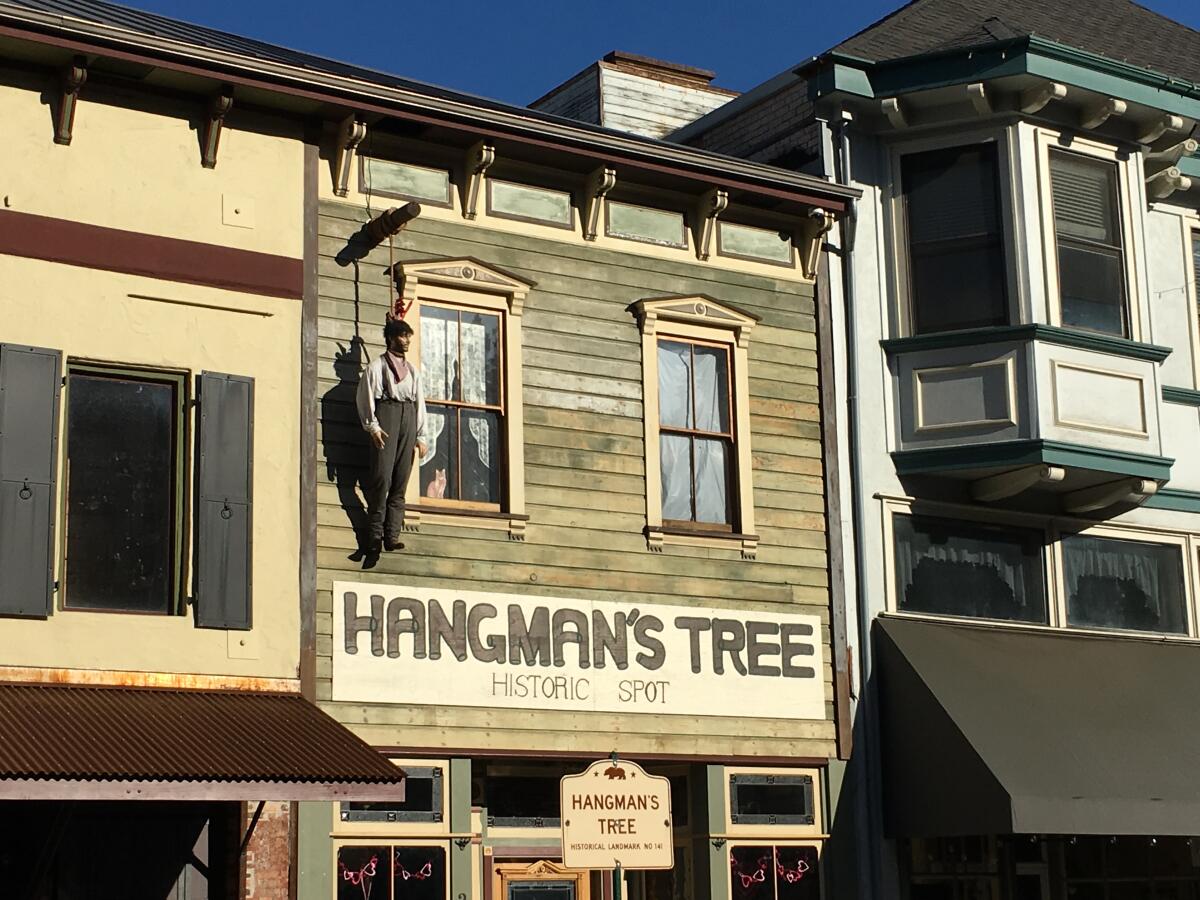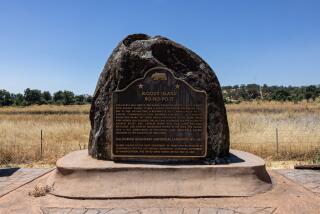Placerville is keeping the nickname ‘Hangtown’ after removing a noose from its logo

Two weeks after Placerville opted to nix a noose depicted on its city logo, officials affirmed that the area’s Gold Rush-era name, “Hangtown,” won’t be going anywhere.
City Council members voted unanimously to recognize that “Old Hangtown” and “Old Dry Diggins,” another moniker tied to the majority-white town’s mining past, are historically significant.
The decision arrives amid continuing acrimony over how to present the area’s Wild West origins. Three nooses were recently found hanging in the city, including two that weren’t removed because they were on private property and did not rise to the level of a crime, according to Placerville police.
Mayor Dennis Thomas said he and Councilman Michael Saragosa brought the item forward this week in light of confusion after the unanimous vote April 13 to scrub the noose from the town’s logo, the result of a debate that took off amid a wave of social justice protests after the police killing of George Floyd.
Between the two votes by the council, former Minneapolis Police Officer Derek Chauvin was convicted of murdering Floyd.
Discussion emerged suggesting the changes in Placerville could be “the beginning of a slippery slope, that it’s part of this whole grand scheme of taking down everything historical in the city,” Thomas said.
Saragosa said the name, which appeared in historical documents and newspapers, is distinct from the symbol of the noose, which was probably incorporated in the city logos in the 1970s and is widely considered a hate symbol.
The city earned its macabre nickname in 1849 after three men accused of robbery and attempted murder were sentenced to death by hanging. The men spoke no English and were not present at the trial where the death sentence was handed down. Some see the event as a triumph of justice, others as a grim example of mob rule.
The resolution is “a good place to be,” Saragosa said, one “that does acknowledge our history, without being on the wrong side of that history going forward.”
Vice Mayor Kara Taylor, a strong proponent of losing the noose in the logo, supported the resolution, though she said it was done reluctantly.
The names are already recognized in a state historic landmark, prompting Taylor’s conclusion that the substance of the resolution is not up for interpretation. The resolution is largely a formal statement, not an ordinance that will create law or result in any action.
“In that regard, I don’t see a reason to oppose this, but I’m not thrilled about having to take this vote,” she said, explaining she wanted to see the issue that has pitted residents against one another put to rest.
Some residents called in to the meeting to say they didn’t see it as an innocuous move.
One caller who opposed the resolution called the discussion “a slap in the face to the vote that you took two weeks ago,” arguing that the noose and the name are cut from the same cloth.
Another caller urging a no vote said, “We accept that as much as we cherish the memories we associate with our name, that love does not justify continuing to use the term that is widely accepted to be a slur.”
But others saw the resolution as useful. Some couched opposition as emblematic of problematic “wokeism,” and others said the names shed light on a past that needs no apology or reframing.
One supportive caller said the names “provide an opportunity for people to live real history when they come to our town. When the marshals walk down the street, when we have the shootout, when we have the stagecoach rides — people are reliving history.”
The roughly 170-year-old name permeates the city.
The greeting “Old Hangtown” still welcomes visitors on a large sign along Highway 50 and is plastered on businesses.
A white oak tree at the center of town was used as a gallows during the Gold Rush era, when the name first appeared. The stump of that tree, all that remains, sits in the cellar of a bar on Main Street “named — quite aptly — The Hangman’s Tree,” according to the city’s website. A dummy named George hangs from a noose above the bar’s second story.
Mining camps in the Gold Rush days frequently meted out justice in an extralegal manner, according to a history presentation by Brendan Lindsay, an associate professor of history at Cal State Sacramento.
It was “often simply referred to as ‘Judge Lynch,’ ” Lindsay said in the presentation prepared at the request of Placerville officials.
Since the mid-April vote, Placerville police have investigated three incidents involving nooses in the city, said Cmdr. Dan Maciel. All were found were within a few days of one another.
Under the state’s penal code, a person who hangs a noose, “knowing it to be a symbol representing a threat to life,” on someone else’s property or for “the purpose of terrorizing” the owner of that property can face up to a year in jail and/or up to a $5,000 fine for a first offense. The same goes for those with those motives who hang a noose at a school, park or place of employment.
No crimes were found to have been committed in each recent case in Placerville, and they’ve been documented and closed, Maciel said.
In the two instances in which nooses were found on private property, it’s believed they were hung by the owners, Maciel said. They were not removed by officers.
“If we’ve determined that no crime has been committed, we have no right to go onto that person’s property and remove something,” Maciel said, citing the 1st Amendment’s freedom of expression.
A noose found hanging on a utility line near a popular hiking public trail was removed. After surveying the area and looking at surveillance footage, “we were unable to determine a motivation,” he said.
More to Read
Sign up for Essential California
The most important California stories and recommendations in your inbox every morning.
You may occasionally receive promotional content from the Los Angeles Times.









